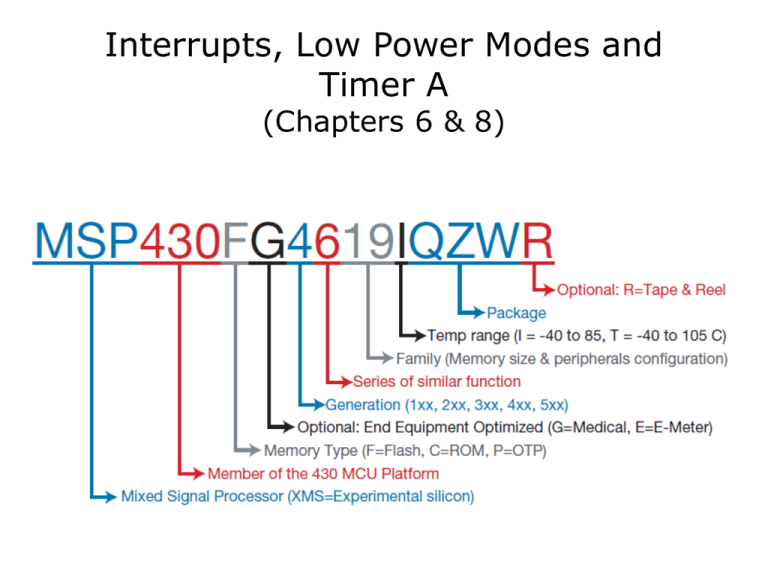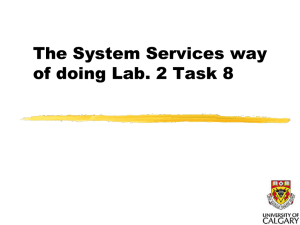MSP430TimerA_Interrupts
advertisement

Interrupts, Low Power Modes and
Timer A
(Chapters 6 & 8)
Registers
Status Register
Interrupts
(Chapter 6 in text)
A computer has 2 basic ways to react to inputs:
1) polling: The processor regularly looks at the input and
reacts as appropriate.
+ easy to implement and debug
- processor intensive
• if event is rare, you waste a lot of time checking
• processor can’t go into low power (slow or stopped) modes
2) interrupts: The processor is “interrupted” by an event.
+ very efficient time-wise: no time wasted looking for an event
that hasn’t occurred.
+ very efficient energy-wise: processor can be asleep most of the
time.
- can be hard to debug
Polling vs Interrupt
This program sets P1.0 based on
state of P1.4.
This program toggles P1.0 on each push
of P1.4.
#include
#include
<msp430x20x3.h>
void main(void)
{
WDTCTL=WDTPW+WDTHOLD;
P1DIR = 0x01;
P1OUT = 0x10;
P1REN |= 0x10;
//
//
//
//
Stop
P1.0
P1.4
P1.4
watchdog
output
hi (pullup)
pullup
while (1) {
// Test P1.4
if (0x10 & P1IN) P1OUT |= 0x01;
else P1OUT &= ~0x01;
}
}
<msp430x20x3.h>
void main(void) {
WDTCTL = WDTPW + WDTHOLD; // Stop watchdog
P1DIR = 0x01;
// P1.0 output
P1OUT = 0x10;
// P1.4 hi (pullup)
P1REN |= 0x10;
// P1.4 pullup
P1IE |= 0x10;
// P1.4 IRQ enabled
P1IES |= 0x10;
// P1.4 Hi/lo edge
P1IFG &= ~0x10;
// P1.4 IFG cleared
_BIS_SR(LPM4_bits + GIE); // Enter LPM4
}
// Port 1 interrupt service routine
#pragma vector=PORT1_VECTOR
__interrupt void Port_1(void) {
P1OUT ^= 0x01;
// P1.0 = toggle
P1IFG &= ~0x10;
// P1.4 IFG cleared
}
The details are not important now, we will come back to the interrupt version
later and go over it line-by-line, bit-by-bit.
What happens on interrupt?
Interrupt Acceptance
The interrupt latency is 6 cycles (CPU), from the acceptance of an interrupt request to the start of
execution of the interrupt-service routine. The interrupt logic executes the following:
1. Any currently executing instruction is completed.
2. The PC, which points to the next instruction, is pushed onto the stack.
3. The SR is pushed onto the stack.
4. The interrupt with the highest priority is selected if multiple interrupts occurred during the last
instruction and are pending for service.
5. The interrupt request flag resets automatically on single-source flags. Multiple source flags
(e.g., I/O ports) remain set for servicing by software.
6. The SR is cleared. This terminates any low-power mode (next slide). Because the GIE bit is
cleared, further interrupts are disabled.
7. The content of the interrupt vector is loaded into the PC: the program continues with the
interrupt service routine at that address.
8. This is different from a typical function call because SR is saved.
Return From Interrupt
The interrupt handling routine terminates with instruction: RETI (return from ISR)
The return from the interrupt takes 5 cycles (CPU) or 3 cycles (CPUx) to execute the following actions.
1. The SR with all previous settings pops from the stack. All previous settings of GIE, CPUOFF, etc.
are now in effect, regardless of the settings used during the interrupt service routine.
2. The PC pops from the stack and begins execution at the point where it was interrupted.
Low power modes
AA battery has capacity of
about 2 Amp-hours.
This is about 2 million hours
(228 years) at 0.1 μA.
Getting into and out of LPM
Getting into and out of LPM
In main routine
(enter LPM mode)
Using C
__bis_SR_register(CPUOFF + GIE);
// LPM0, ADC10_ISR will force exit
// . . .
// ADC10 interrupt service routine
#pragma vector=ADC10_VECTOR
__interrupt void ADC10_ISR(void) {
__bic_SR_register_on_exit(CPUOFF);
}
In ISR (exit LPM when
returning to main program).
// Clear CPUOFF bit from 0(SR)
_bis_SR_register(unsigned short mask);
_bic_SR_register_on_exit(unsigned short mask);
//BIS mask, SR
//BIC mask, saved_SR
Registers that effect interrupts on P1
If a bit in PIES=0, the corresponding bit in P1IFG is set on rising edge on corresponding
input pin (P1IN).
If PIES=1, P1IFG is set on falling edge of P1IN.
If interrupt enable bit is set in (P1IE), and Global Interrupts are enabled (GIE in Status
Register), an interrupt is requested when the corresponding interrupt flag is set (P1IFG).
Using interrupts on Port 1
Toggles P1.0 on each push of P1.4.
P1.0 is output
void main(void) {
WDTCTL = WDTPW + WDTHOLD;
P1DIR = 0x01;
P1OUT = 0x10;
P1REN |= 0x10;
P1IE |= 0x10;
P1IES |= 0x10;
P1IFG &= ~0x10;
P1.4 resistor is enabled
_BIS_SR(LPM4_bits + GIE);
//
//
//
//
//
//
//
Stop
P1.0
P1.4
P1.4
P1.4
P1.4
P1.4
watchdog
output
hi (pullup)
pullup
IRQ enabled
Hi/lo edge
IFG cleared
// Enter LPM4
}
// Port 1 interrupt service routine
#pragma vector=PORT1_VECTOR
__interrupt void Port_1(void) {
P1OUT ^= 0x01;
// P1.0 = toggle
P1IFG &= ~0x10;
// P1.4 IFG cleared
}
P1.4 resistor is connected to logic 1
Enable interrupt on P1.4 (GIE is still
cleared)
Set sensitivity to falling edge.
Clear Interrupt flag (just in case).
Enter LPM4 and enable interrupts
Tell compiler to fill in interrupt vector
with address of this function
Tell compiler to return from function
with “iret” (as opposed to “ret”)
Toggle P1.0
Clear interrupt flag.
(Some interrupts do this
automatically, check manual, or example code)
Keep ISR’s short!
It is important to keep interrupt service routines short. Since interrupts are disable globally
during an ISR, you might miss something important.
If you need to do a lot of processing, have the ISR set a flag, and have main routine act on it.
TIMER A
MSP430G2533 has two of them
(Chapter 8 in text – MSP430G2533 has two of them)
Timer A
Timer / Counter
Note interrupt flags
Capture Compare Register
(3 copies, CCR0, CCR1, CCR2)
TACCR0 comes up on
next slide.
Timer / Counter
• The timer register (TAR) can be read and written
and can generate an interrupt on overflow.
It can be cleared with TACLR.
• TASSELA selects on of four inputs
• IDA chooses one of four divider
• MCA chooses one of four counting modes
See previous page
for definition
TIMER A Registers
If we wanted to use TAIFG for a periodic interrupt, the ISR would have to set
the value of TAR to 0xffff-(desired delay count – 1).
Capture Mode
Capture mode (CAP=1) is used to time events on CCIxA or CCIxB (where x is the CCR register).
On a rising edge, falling edge, or both (as determined by CMx) the value of TAR is copied into
TACCRx, and the CCIFG flag is set.
TACCTLx Register
Compare Mode
Compare Mode used to generate periodic
signals of whose frequency and duty cycles can
be altered.
Exact behavior is set by bit EQUx and OUTMODx.
As one example:
• TAR counts to TACCR0 and resets (i.e.,
TACCR0 determines frequency (along with TAR input frequency))
• Output OUT1 is high when TAR>TACCR1 (i.e., TACCR1 determines pulse width)
PWM
If you need PWM, you need to choose the mode you need:
PWM modes
Lab this week









